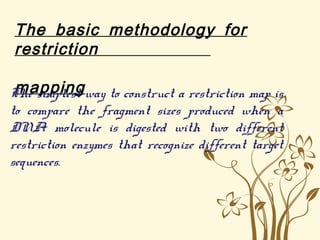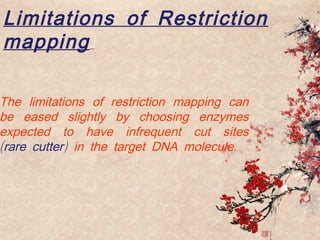Genome Mapping
- 1. Submitted By-: Priya Chaturvedi M.Sc 3rd Sem Roll No.-:1634016
- 2. Introduction Types Genetic mapping Markers for genetic mapping DNA markers RFLP SSLPs SNPs Physical mapping Techniques Importance of genetic mapping -:Contents
- 3. • Genome mapping is the process of finding the location of genes on each chromosome. • It is a critical step in identifying the genes involved in a genetic disease. • Once a disease gene is accurately located, we can determine its DNA sequence and study its protein product. Introduction
- 4. Genome mapping methods can be divided into two categories-: Genetic mapping Physical mapping Types
- 5. 1- Genetic Mapping Uses genetic techniques to construct maps showing the positions of genes and other sequence features on a genome. Genetic techniques include cross-breeding experiments or, in the case of humans, the examination of family histories (pedigrees).
- 6. • The first genetic maps, constructed in the organisms such as the fruit fly, used genes as markers. • The only genes that could be studied were those specifying phenotypes that were distinguishable by visual examination. Eg. Eye colour, height. • Some organisms have very few visual characteristics so gene mapping with these organisms has to rely on biochemical phenotypes. Markers For Genetic Mapping
- 8. Markers In Human • In human the biochemical phenotypes that can be scored by blood typing. • These include the standard blood groups such as the ABO series and also the human leukocyte antigens (the HLA system).
- 9. Drawbacks of using gene as marker Genes are very useful markers but they are by no means ideal. One problem, especially with larger genomes such as those of vertebrates and flowering plants, is that a map based entirely on genes is not very detailed.
- 10. DNA markers As with gene markers, a DNA marker must have at least two alleles to be useful. There are three types of DNA sequence feature that satisfy this requirement: Restriction Fragment Length Polymorphisms (Rflps), Simple Sequence Length Polymorphisms (Sslps), and Single Nucleotide Polymorphisms (Snps).
- 11. RFLP The DNA molecule on the left has a polymorphic restriction site (marked with the asterisk) that is not present in the molecule on the right. The RFLP is revealed after treatment with the restriction enzyme because one of the molecules is cut into four fragments whereas the other is cut into three fragments.
- 12. Simple Sequence Length Polymorphisms ( )Sslps • SSLPs are arrays of repeat sequences that display length variations, different alleles containing different numbers of repeat units • Unlike RFLPs that can have only two alleles, SSLPs can be multi-allelic as each SSLP can have a number of different length variants. • There are two types of SSLP, both of which were described in • Mini satellites , also known as variable number of tandem repeats(VNTRs), in which the repeat unit is up to 25 bp in
- 13. Single nucleotide ( )polymorphisms SNPs These are positions in a genome where some individuals have one nucleotide (e.g. a G) and others have a different nucleotide (e.g. a C)). There are vast numbers of SNPs in every genome, some of which also give rise to RFLPs, but many of which do not because the sequence in which they lie is not recognized by any restriction enzyme.
- 14. Advantages Of SNPs The advantages of SNPs are their abundant numbers and the fact that they can be typed by methods that do not involve gel electrophoresis. This is important because gel electrophoresis has proved difficult to automate so any detection method that uses it will be relatively slow and labour- intensive. SNP detection is more rapid because it is based on oligonucleotide hybridization
- 15. Oligonucleotide hybridization Oligonucleotide hybridization can therefore discriminate between the two alleles of an SNP. Various screening strategies have been devised including DNA chip technology and solution hybridization techniques
- 16. -2 Physical Mapping Uses molecular biology techniques to examine DNA molecules directly in order to construct maps showing the positions of sequence features, including genes.
- 17. ..Conti • A map generated by genetic techniques is rarely sufficient for directing the sequencing phase of a genome project. This is for two reasons: The resolution of a genetic map depends on the number of crossovers that have been scored. Genetic maps have limited accuracy
- 18. Techniques Restriction mapping, which locates the relative positions on a DNA molecule of the recognition sequences for restriction endonucleases; Fluorescent in situ hybridization(FISH), in which marker locations are mapped by hybridizing a probe containing the marker to intact chromosomes; Sequence tagged site (STS) mapping, in which the positions of short sequences are mapped by PCR and/or
- 19. The basic methodology for restriction mappingThe simplest way to construct a restriction map is to compare the fragment sizes produced when a DNA molecule is digested with two different restriction enzymes that recognize different target sequences.
- 20. Limitations of Restriction mapping The limitations of restriction mapping can be eased slightly by choosing enzymes expected to have infrequent cut sites ( )rare cutter .in the target DNA molecule
- 21. Rare Cutters • These ‘rare cutters' fall into two categories-: Enzymes with seven- or eight-nucleotide recognition sequences Enzymes whose recognition sequences contain motifs that are rare in the target DNA
- 22. el stretching and molecular combi
- 23. Fluorescent in situ hybridizati
- 24. Importance of gene mapping Gene map is the anatomy of human genome. It is a per requisite to understand functioning of human genome. Helps in analysis of the heterogeneity and segregation of human genetic diseases. Helps to develop methods for gene therapy. Provides clinically useful information about linkage
























